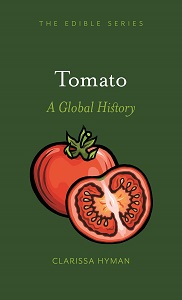
Do you ever wonder where the ingredients in your tamale came from?
Each volume in Reaktion Books'
Edible series explores the global history and culture of a type of food. These little books pack in several chapters on various cultural histories around the crop they explore. It is essentially a food memoir and at the end of the each book, recipes are provided.
In
Corn: A Global History, by Michael Owen Jones, readers learn it is hard to determine how corn originated, due to its need for humans to cultivate it. Corn cannot grow wild. We also learn that maize is classified based on the grain’s appearance and starch content. The book contains a large section on Indigenous foods based on corn.

In
Tomato: A Global History, by Clarissa Hyman, we learn that the word derived from the Nahuatl ‘
tomatl’, a generic term for a globose fruit or berry with seeds and watery flesh sometimes enclosed in a membrane. This ambitious memoir explores the tomato’s migration throughout the New World to the Old World, including Italy. One of my favorite pizzas, the Margherita, was created in 1889 in Naples to honor the Italian queen of the same name. The book investigates tomato cultivation today, including how scientific advances are changing the fruit, while conservation of heirloom varieties continues.
 Avocado: A Global History
Avocado: A Global History, by Jeff Miller, explores the history and current social media craze of the fruit and describes how it has been grown on every continent except Antarctica. What I found the most intriguing is how avocados are in the laurel family, the oldest group of flowering plants, with the term laurels denoting excellence. Like corn, beans and tomatoes, the avocado's history can be traced back to the ecological conditions of the Neogene period, which created the Mesoamerican land-bridge that joined the continents of North and South America, creating a habitat for these foods to evolve into what we know today.
 Beans: A Global History
Beans: A Global History, by Natalie Rachel Morris, explores the staple food’s humble beginnings over 9,000 years ago. The diverse genus includes many different varieties and the food can be used in many forms: dried, frozen or canned. The substantial nutritional benefit of the food led to the people of Tuscany being known as “bean-eaters”. I especially enjoyed the chapter on the lore and literature of beans.
Together, the books are a feast of knowledge. They are best enjoyed before a meal.